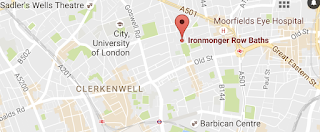Coram's Fields, Coram & The Foundling Museum
Coram's Fields, and Coram & The Foundling Museum, are located between Brunswick and Mecklenberg Squares, Bloomsbury, London. The complicated, intertwined institutional histories of these three entities are unwound here.
 |
| The Foundling Hospital Wikipedia Commons |
In the mid-1700s, the 56 acres of the Earl of Salisbury’s estate in rural London were bought up and dedicated to a Foundling Hospital. Its legacy survives in the form of three modern institutions still located on or adjacent to the same site just east of the Russell Square tube station in Bloomsbury, Borough of Camden.
Coram’s Fields and the Foundling Hospital
Bloomsbury residents are well acquainted with Coram’s Fields — a football pitch for after school use and a playground especially for children. Adults over age 16 are not allowed in without a child under age 16 in tow, except for organized football games on a pitch available for rent lunchtimes and evenings Monday through Friday. On site there are a children’s playground, youth centre, paddling pool, nursery, wildlife garden, and petting zoo of various animals: sheep sometimes graze by the iron railings, and a peacock used to crow in the quiet of a Sunday morning — sadly missed as the peacock is no longer in residence.
Coram’s Fields bears the name of the founder of the Foundling Hospital charity, Captain Thomas Coram, a shipwright turned philanthropist. Having obtained a Royal Charter from King George II in 1739, he established a hostel (hospital) for “reluctantly deserted” infants (in the words of the Museum display). A set of Governors empowered by Parliament ran the hospital, and one, Theodore Jacobsen, designed the hospital building — a rather imposing brick building with two wings, for boys and girls respectively, completed in 1752. Between these wings was a chapel in which George Frederic Handel, a patron of the Hospital, performed annual charity concerts of his works.
Between 1796 and 1799, two squares of enclosed land were established alongside the hospital grounds. These were named Brunswick and Mecklenberg in honour of King George III’s German heritage. The original hostel was demolished after the site was sold in 1926 to developers, but the enclosures live on as Brunswick and Mecklenberg Squares.
In the 1930s, the Foundling Hospital charity bought back part of the original site, while another larger parcel was bought by locally raised funds from Lord Rothermere and donations from the Harmsworth family. These seven acres were re-established as today’s “Coram’s Fields & the Harmsworth Memorial Playground”, now owned and run by the eponymous charity.
 |
| Alcove for receiving babies |
 |
| West Gate |
The east and west side gates and railings of the original site form today’s entrance to Coram’s Fields. Between the gatehouses stands the original stone alcove in which a basket was placed to receive unwanted babies. Those structures, together with sections of the
eastern and western colonnades and a memorial pavilion
built in 1936, constitute Grade II listed buildings in Camden.
 |
| Pavilion |
 |
| Colonnade |
The Foundling Museum: Hogarth and Handel Collections
The Foundling Hospital facilities had inadvertently become the England’s first art gallery and concert hall, due to the donations of several artists including William Hogarth — another Governor, Handel, Gainsborough, Hayman, Ramsay, Reynolds and Rysbrack. Thus, after selling the original hospice site in 1926, the charity built new headquarters in 1937 at No 40 Brunswick Square, in which their treasured art works and documents could be stored and displayed. A bust of Thomas Coram overlooks the entranceway, and inside, several architectural features saved from the original hospital were built into the charity’s new home — including the ornate wooden staircase from the Boys’ Wing, and the ‘Court Room’, an 18th century Rococo interior designed by Hogarth where the Governors used to meet.
In 1952 the Foundling Hospital charity changed its name to the Thomas Coram Foundation for Children; then in 1998 a new Foundling Museum charity was separately established. The Foundation’s name was again changed in 1999 to the Coram Family, and it moved out of the 1937 building, leaving it as a museum, to the Coram Community Campus, newly built next door.
The Foundling Museum, open to the public from 2004, houses documents telling the history of the Foundling Hospital and the works of famous patrons. Equally interesting is the collection of tokens that mothers attached to their children when given up to the hospice: beaded bracelets, rings and pendants. A modernist Corum Café offers refuge from the rain and respite for the feet, while concerts, conferences and gallery talks draw people from far and wide.
 |
| Corum's football pitch adjoining Brunswick Square |
Corum and the Coram Community Campus
In 2007, Corum Family changed its name again to simply Corum. The charity continues the original remit of the Foundling Hospital for the “maintenance and Education of exposed and deserted children” (Malcolm Holmes, n.d.) by providing support and practical help for vulnerable children. But interestingly, it has widened concern to include the family context in the modern age. The Corum Adoption Service, for example, offers parenting skills workshops and provides support for adoptive families.
The Corum Community Campus occupies the northern end of the original Foundling Hospital grounds. The northern boundary wall survives, dividing the Campus from St George’s Gardens and cemetery, as well as some back outbuildings, originally part of the service complex consisting of the laundry, swimming baths, and infirmary. The newly built Campus offers creches, after-school clubs and music therapy sessions for neighbourhood residents.
Reference:
Holmes, Malcolm (n.d.) The Foundling Hospital. London: Coram’s Fields & The Harmsworth Memorial Playground.






